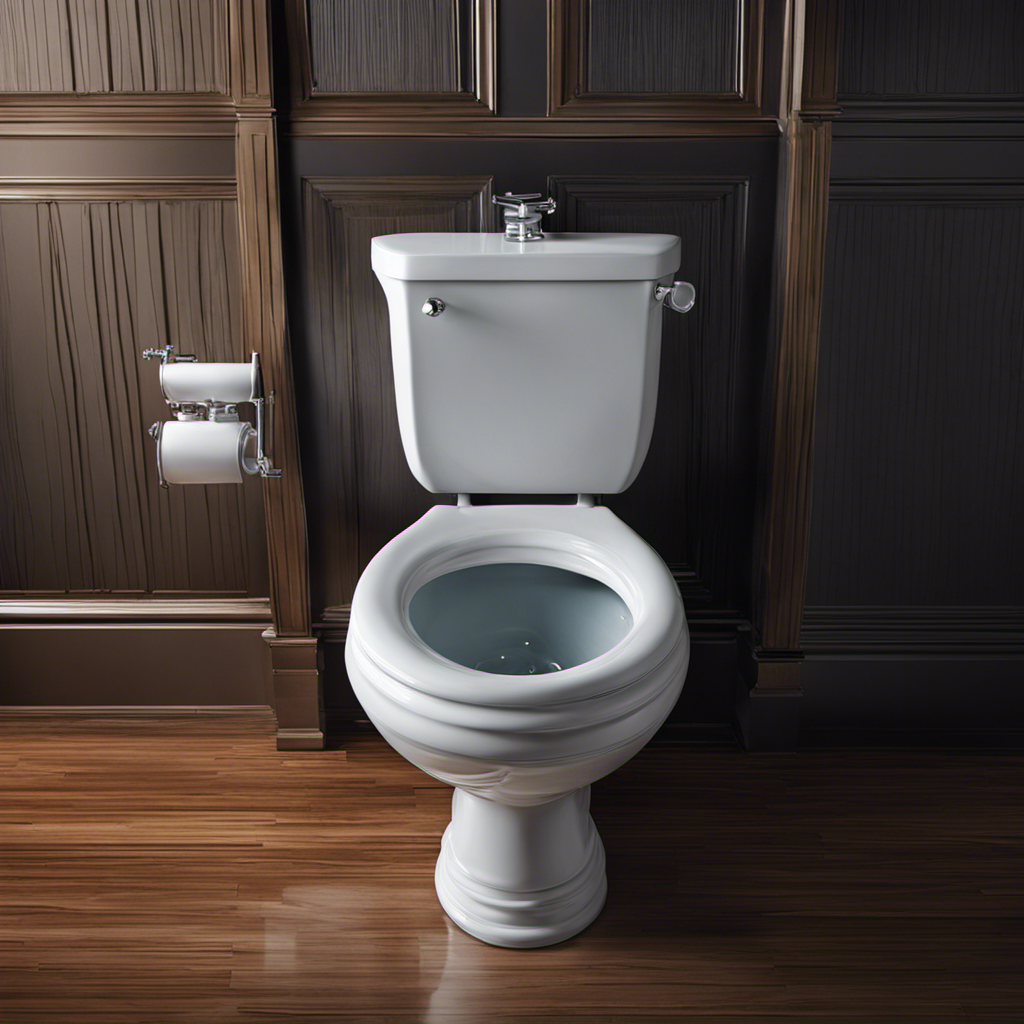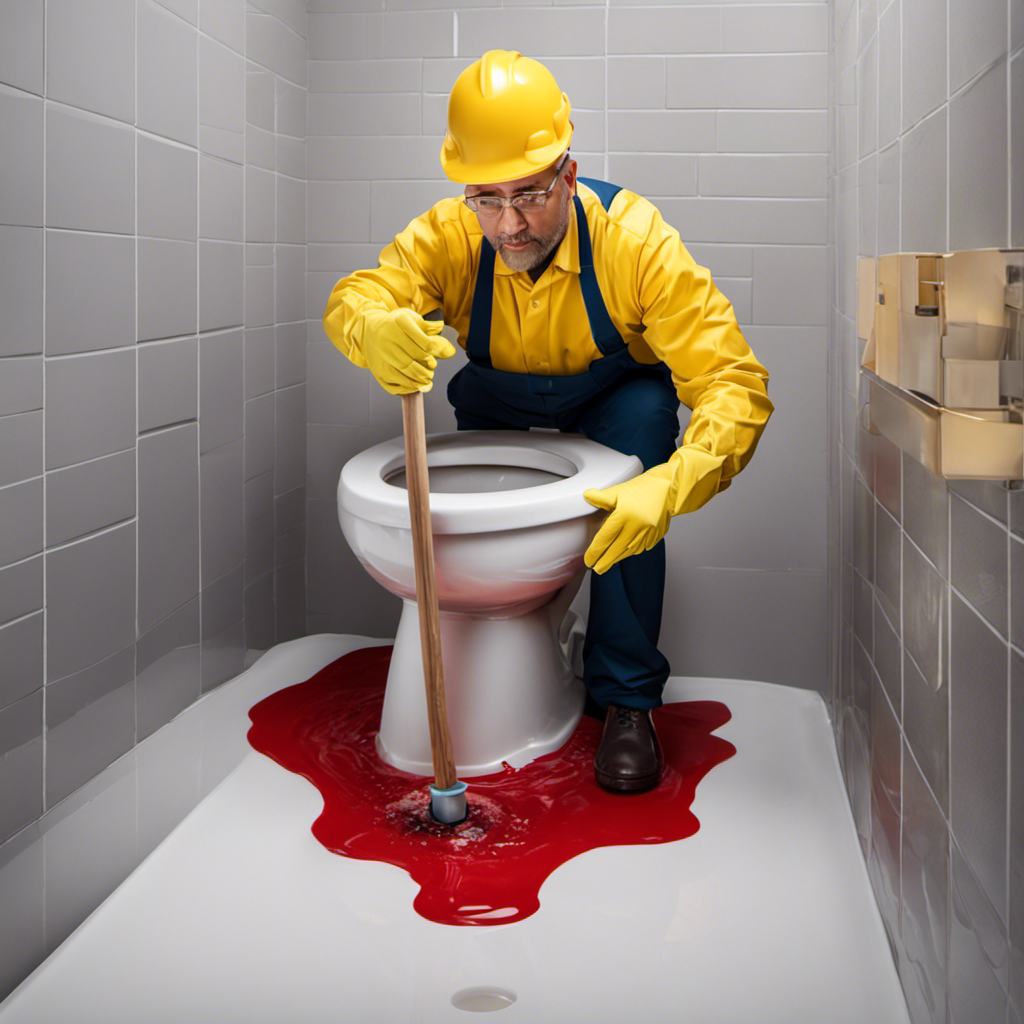Are you tired of the constant sound of water running in your bathroom? Imagine being able to fix that annoying problem yourself, without having to call a plumber.
In this article, we will guide you through the steps to fix a constantly running toilet. By following our simple instructions, you will be able to:
- Identify the issue
- Check the flapper valve
- Adjust the float ball
- Examine the fill valve
- Clean the flush valve
- Replace the necessary toilet parts
Let’s get started and put an end to that never-ending sound.
Key Takeaways
- Check the flapper valve for proper sealing and adjust the chain length if necessary.
- Inspect the fill valve and float for any issues and make adjustments or replacements as needed.
- Regular maintenance of the flapper valve, fill valve, and float can prevent leaks and water wastage.
- Proper care and regular maintenance of toilet parts can help prolong their lifespan and avoid common problems.
Identifying the Issue
First, you’ll need to check if the flapper valve is causing the problem. A common issue with a constantly running toilet is a faulty flapper valve. This valve is responsible for sealing the opening at the bottom of the tank and preventing water from continuously flowing into the bowl.
To troubleshoot this, start by removing the tank lid and observing the flapper valve. Ensure that it is properly sealing the opening. If not, it may be worn out or misaligned. In that case, you can try adjusting the chain length or replacing the flapper altogether.
Another common issue is a faulty fill valve or float. If the water level is too high, it can cause the toilet to run continuously. Check these components for any defects and make the necessary adjustments or replacements.
Checking the Flapper Valve
When it comes to checking the flapper valve in your toilet, there are three key points to consider: flapper valve replacement, adjusting the flapper chain, and cleaning the flapper.
If you notice that your toilet is constantly running, it may be a sign that the flapper valve needs to be replaced.
Additionally, adjusting the flapper chain can help ensure proper functioning of the flapper valve, while cleaning the flapper can help remove any debris that may be preventing it from sealing properly.
Flapper Valve Replacement
To fix the constantly running toilet, you’ll need to replace the flapper valve. The flapper valve is responsible for controlling the flow of water from the toilet tank into the bowl. Over time, the flapper valve can become worn or damaged, causing it to not seal properly and allowing water to continuously leak into the bowl. Replacing the flapper valve is a relatively simple task that can be done with just a few tools and some basic plumbing knowledge. Here’s a step-by-step guide to help you replace the flapper valve in your toilet:
| Tools Needed | Materials Needed | Steps |
|---|---|---|
| Adjustable wrench | Flapper valve | 1. Shut off the water supply to the toilet by turning the shut-off valve clockwise. |
| Screwdriver | Rubber gasket (if necessary) | 2. Empty the water from the tank by flushing the toilet. |
| Replacement flapper valve | 3. Remove the old flapper valve by disconnecting the chain from the flush handle and unscrewing the mounting nut. | |
| 4. Install the new flapper valve by attaching the chain to the flush handle and securing the mounting nut. | ||
| 5. Turn on the water supply and test the toilet to ensure it is no longer running. | ||
| 6. Adjust the chain length if necessary to ensure proper flushing. |
Adjusting Flapper Chain
Adjusting the flapper chain ensures proper flushing and prevents water from continuously leaking into the toilet bowl. Follow these steps to adjust the flapper chain:
-
Turn off the water supply to the toilet by shutting off the valve located behind the toilet.
-
Remove the toilet tank lid and locate the flapper chain connected to the flush valve.
-
Check the length of the chain. It should have a slight slack, allowing the flapper to fully close. If the chain is too loose, it can prevent the flapper from sealing tightly and cause a continuous leak.
-
To tighten the connection, simply adjust the length of the chain by either removing or adding chain links.
-
Once the chain is properly adjusted, turn the water supply back on and test the toilet for any leaks.
If adjusting the chain doesn’t solve the issue, you may need to consider replacing the chain altogether.
Cleaning the Flapper?
If you notice buildup or debris on the flapper, you can clean it by gently wiping it with a damp cloth. Regular toilet flapper maintenance is essential to ensure proper functioning of your toilet.
Over time, the flapper can accumulate mineral deposits, mold, or other debris that may interfere with its sealing ability. By cleaning the flapper, you can remove any obstructions and restore its effectiveness.
Troubleshooting toilet flapper issues often involves examining and cleaning the flapper. To clean the flapper, start by turning off the water supply to the toilet. Then, remove the flapper from its seat and inspect it for any signs of buildup or damage. If necessary, use a soft cloth and some water to gently wipe away any debris.
Once the flapper is clean, reattach it to its seat and turn the water supply back on. Regular flapper cleaning can help prevent leaks and keep your toilet running smoothly.
Adjusting the Float Ball
First, check to see if the float ball is positioned correctly in the toilet tank. The float ball is responsible for regulating the water level in the tank. If it is not functioning properly, it can cause the toilet to constantly run.
Here are the steps to adjust the float ball and ensure proper water level:
- Turn off the water supply to the toilet by shutting off the valve located behind the toilet.
- Lift the lid of the toilet tank and locate the float ball. It is usually attached to the fill valve.
- Adjust the float ball by bending the metal rod attached to it. If the water level is too high, bend the rod downwards. If it is too low, bend the rod upwards.
Regular float ball maintenance is essential to prevent water wastage and ensure the efficient operation of your toilet.
Examining the Fill Valve
To begin troubleshooting issues with your toilet’s fill valve, start by inspecting the valve for any visible signs of damage or debris.
If the valve appears to be in good condition, you can then proceed to adjust the fill valve to ensure proper water flow and tank fill levels.
However, if the fill valve is beyond repair or adjustment, replacing it may be necessary to resolve the problem and restore your toilet’s functionality.
Fill Valve Troubleshooting
The first step in troubleshooting the fill valve is to ensure that the water supply to the toilet is turned on. Once you have confirmed this, you can proceed with the following steps to address common fill valve issues:
-
Check for clogs: Inspect the fill valve for any debris or mineral buildup that may be obstructing the flow of water. Use a small brush or toothbrush to clean any blockages.
-
Adjust the float: The float is responsible for controlling the water level in the tank. If the water continues to run, try adjusting the float by either bending the arm or lowering the float itself.
-
Replace the fill valve: If the above steps do not resolve the issue, it may be necessary to replace the fill valve. This is a straightforward process that involves shutting off the water supply, removing the old valve, and installing a new one.
Adjusting Fill Valve
When adjusting the fill valve, make sure to bend the arm or lower the float to control the water level in the tank.
The water level in the tank is crucial for the proper functioning of your toilet. If the water level is too high, it may cause the toilet to continuously run, wasting water and increasing your utility bills.
To adjust the water level, locate the fill valve in the toilet tank. Depending on the type of fill valve you have, you can either bend the arm to lower the float or adjust the float itself.
It’s important to perform regular fill valve maintenance to ensure optimal performance and prevent any potential issues with your toilet.
Replacing Fill Valve
Make sure you have the correct tools before replacing the fill valve in your toilet. Here are the steps to replace the fill valve:
-
Shut off the water supply: Locate the shut-off valve behind your toilet and turn it clockwise to stop the water flow. This will prevent any leaks while replacing the fill valve.
-
Drain the tank: Flush the toilet to drain the water from the tank. You can also use a sponge or towel to soak up any remaining water.
-
Remove the old fill valve: Disconnect the water supply line from the fill valve. Unscrew the nut underneath the tank and remove the old fill valve.
Remember to perform regular fill valve maintenance to prevent future leaks. Troubleshooting toilet leaks can be time-consuming and costly, so it’s important to take proper care of your toilet’s fill valve.
Cleaning the Flush Valve
To clean the flush valve, you’ll need to first shut off the water supply to the toilet. This is important to prevent any water from flowing while you work on the valve.
Once the water is shut off, you can proceed with cleaning the flush valve. Start by preparing a cleaning solution using a mixture of vinegar and water or a commercial cleaner recommended for toilets.
Next, grab your cleaning tools, such as a toilet brush or a scrub brush with stiff bristles. Dip the brush into the cleaning solution and scrub the flush valve thoroughly, removing any mineral deposits or debris that may be causing it to malfunction.
Rinse the valve with clean water and turn the water supply back on to see if the issue is resolved.
Replacing the Toilet Parts
If you’re experiencing a leaky toilet, it may be time to replace the toilet parts. Regular toilet maintenance is crucial to avoid common toilet problems like constant running or water leaks.
Here’s what you need to know about replacing the toilet parts:
-
Identify the problematic part: Determine which component is causing the issue. It could be the flapper, fill valve, or flush valve.
-
Gather the necessary tools: To replace the toilet parts, you’ll need a wrench, pliers, and a new replacement part.
-
Follow the manufacturer’s instructions: Different toilet models may require specific steps for replacing the parts. Consult the user manual or online resources for guidance.
Conclusion
In conclusion, fixing a constantly running toilet is an easy task that anyone can tackle. By following the steps outlined in this article, you can effectively identify and resolve the issue causing your toilet to run continuously.
Just like fixing a leaky faucet can save you gallons of water, fixing a running toilet can also help conserve water and save you money on your water bill.
So don’t let that toilet run unchecked, take action today and become a water-saving hero!










